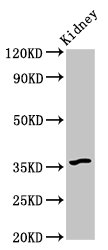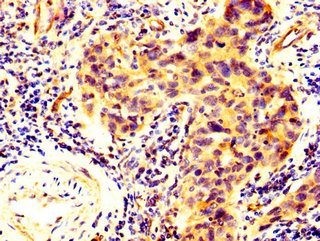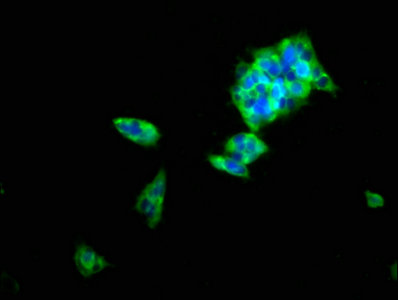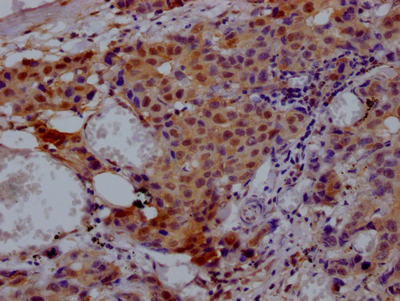-
货号:CSB-PA819471LA01HU
-
规格:¥880
-
图片:
-
Western Blot
Positive WB detected in: Mouse kidney tissue
All lanes: GPBAR1 antibody at 6μg/ml
Secondary
Goat polyclonal to rabbit IgG at 1/50000 dilution
Predicted band size: 36 kDa
Observed band size: 36 kDa -
IHC image of CSB-PA819471LA01HU diluted at 1:300 and staining in paraffin-embedded human bladder cancer performed on a Leica BondTM system. After dewaxing and hydration, antigen retrieval was mediated by high pressure in a citrate buffer (pH 6.0). Section was blocked with 10% normal goat serum 30min at RT. Then primary antibody (1% BSA) was incubated at 4°C overnight. The primary is detected by a biotinylated secondary antibody and visualized using an HRP conjugated SP system.
-
Immunofluorescence staining of 293 cells with CSB-PA819471LA01HU at 1:100, counter-stained with DAPI. The cells were fixed in 4% formaldehyde, permeabilized using 0.2% Triton X-100 and blocked in 10% normal Goat Serum. The cells were then incubated with the antibody overnight at 4°C. The secondary antibody was Alexa Fluor 488-congugated AffiniPure Goat Anti-Rabbit IgG(H+L).
-
-
其他:
产品详情
-
产品名称:Rabbit anti-Homo sapiens (Human) GPBAR1 Polyclonal antibody
-
Uniprot No.:Q8TDU6
-
基因名:
-
别名:GPBAR1; TGR5; G-protein coupled bile acid receptor 1; G-protein coupled receptor GPCR19; hGPCR19; Membrane-type receptor for bile acids; M-BAR; hBG37; BG37
-
宿主:Rabbit
-
反应种属:Human, Mouse
-
免疫原:Recombinant Human G-protein coupled bile acid receptor 1 protein (283-330AA)
-
免疫原种属:Homo sapiens (Human)
-
标记方式:Non-conjugated
本页面中的产品,GPBAR1 Antibody (CSB-PA819471LA01HU),的标记方式是Non-conjugated。对于GPBAR1 Antibody,我们还提供其他标记。见下表:
-
克隆类型:Polyclonal
-
抗体亚型:IgG
-
纯化方式:>95%, Protein G purified
-
浓度:It differs from different batches. Please contact us to confirm it.
-
保存缓冲液:Preservative: 0.03% Proclin 300
Constituents: 50% Glycerol, 0.01M PBS, pH 7.4 -
产品提供形式:Liquid
-
应用范围:ELISA, WB, IHC, IF
-
推荐稀释比:
Application Recommended Dilution WB 1:500-1:5000 IHC 1:100-1:300 IF 1:50-1:200 -
Protocols:
-
储存条件:Upon receipt, store at -20°C or -80°C. Avoid repeated freeze.
-
货期:Basically, we can dispatch the products out in 1-3 working days after receiving your orders. Delivery time maybe differs from different purchasing way or location, please kindly consult your local distributors for specific delivery time.
相关产品
靶点详情
-
功能:Receptor for bile acid. Bile acid-binding induces its internalization, activation of extracellular signal-regulated kinase and intracellular cAMP production. May be involved in the suppression of macrophage functions by bile acids.
-
基因功能参考文献:
- Activation of FXR inhibits, whereas TGR5 activation may promote, cholangiocarcinoma progression by regulating proliferation, migration and mitochondrial energy metabolism. PMID: 28916388
- RYGB increased circulating bile acids, ileal Takeda G protein-coupled receptor 5 (TGR5) and mTORC1 signaling activity, as well as GLP-1 production in both mice and human subjects. Inhibition of ileal mTORC1 signaling by rapamycin significantly attenuated the stimulation of bile acid secretion, TGR5 expression and GLP-1 synthesis induced by RYGB in lean and diet-induced obese mice. PMID: 29859856
- TGR5 is strongly expressed in collecting ducts, distal convoluted tubules and thin loop of Henle. TGR5 protein and mRNA expression were notably decreased in clear cell renal cell carcinomas and may be helpful in differentiating these tumors from other renal cell carcinomas. PMID: 29606134
- The findings suggest that activation of TGR5 promoted mitochondrial biogenesis in endothelial cells, which is mediated by the CREB/PGC-1a signaling pathway. PMID: 29709472
- Higher-order oligomers, likely with a tetramer organization, are formed from dimers, the smallest unit suggested for TGR5 Y111A variants. PMID: 27833095
- Data suggest that TGR5 and FXR in intestinal mucosa are important for glucose homeostasis, in particular in metabolic disorders such as type 2 diabetes and obesity. (TGR5 = membrane-type receptor for bile acids TGR5; FXR = farnesoid X receptor) [REVIEW; Congress as Topic] PMID: 27846919
- GPBAR1 is expressed in advanced gastric cancers and its expression correlates with markers of epithelial-mesenchymal transition PMID: 27409173
- TGR5 activation induces mitochondrial biogenesis and prevents renal oxidative stress and lipid accumulation, establishing a role for TGR5 in inhibiting Kidney Disease in Obesity and Diabetes Mellitus. PMID: 27045028
- TGR5 exhibits significantly higher expression in NSCLC tumor samples and facilitates the growth and metastasis of NSCLC by activating the JAK2/STAT3 signaling pathway. PMID: 29074425
- TGR5 may have a role in the progression from Barrett's Esophagus to high-grade dysplasia and esophageal adenocarcinoma PMID: 28293080
- contributes to hepatic cystogenesis by increasing cAMP and enhancing cholangiocyte proliferation PMID: 28543567
- anti-inflammation therapy targeting Gpbar1/NF-kappaB pathway could be effective in suppressing bile acid-induced inflammation and alleviating Intrahepatic cholestasis of pregnancy-associated fetal disorders. PMID: 27402811
- human TGR5 (hTGR5) shows higher nomilin responsiveness than does mouse TGR5. PMID: 28594916
- bile acids promote intestinal epithelial cell proliferation and decrease mucosal injury by upregulating TGR5 expression in obstructive jaundice. PMID: 28034761
- The generated contour maps revealed the important structural insights for the activity of the compounds. The results obtained from this study could be helpful in the development of novel and more potent agonists of TGR5. PMID: 27267434
- TGR5 functions as a tumor-suppressor in patients with ampullary adenocarcinoma and preoperative hyperbilirubinemia PMID: 27510297
- We conclude that Claudin-2 expression is significantly associated with bile acid receptors VDR and TGR5 expression. Our studies identify a novel role of a tight junction protein in the development and progression of esophageal mucosal metaplasia, dysplasia and carcinoma. PMID: 28212604
- this is the first report of bile acid derivatives able to antagonize GPBAR1 and and farnesoid X receptor (FXR) modulatory activity. PMID: 26607331
- These findings identify TGR5 as a suppressor of gastric cancer cell proliferation and migration PMID: 26417930
- Because elevated levels of circulatory LPS may contribute to the development of insulin resistance, the results from this study suggest that bile acids through the activation of TGR5 may have a role in the development of insulin resistance as well. PMID: 25418122
- TGR5 is a mediator of bile acid-induced cholangiocyte proliferation and protects cholangiocytes from apoptosis but may trigger proliferation and apoptosis resistance in malignantly transformed cholangiocytes, promoting cholangiocarcinoma. PMID: 26420419
- Collectively, these data suggest the involvement of TGR5 in PLD and that TGR5 targeting in cystic cholangiocytes may have therapeutic potential. PMID: 26045278
- GPBAR1 plays a role in secondary bile acid induced vasodilation via reglation of cystathionine gamma-lyase. The GPBAR1/CSE pathway might contribute to endothelial dysfunction and hyperdynamic circulation in liver cirrhosis. PMID: 25934094
- Study demonstrates that highly lipophilic 3-epi-betulinic acid derivatives can be potent and selective TGR5 agonists with improved cellular efficacy. PMID: 25283506
- GPBAR1 SNP is associated with symptoms and pathobiology in IBS-D and IBS-C. PMID: 25012842
- Our findings strongly suggested the combination of serum TGR5 promoter methylation and AFP enhanced the diagnostic value of AFP alone in discriminating HCC from CHB patients. PMID: 24465162
- the secondary structure of the TGR5 membrane-proximal C terminus is the determining factor for plasma membrane localization and responsiveness towards extracellular ligands. PMID: 24338481
- Data suggest that TGR5 is expressed in 2 cell types of term placenta, macrophage/trophoblast; TGR5 expression is low in maternal cholestasis; TGR5 appears to trigger different responses to bile acid/progesterone metabolites depending on cell type. PMID: 23849932
- DCA, taurolithocholic acid, and oleanolic acid did not stimulate TGR5 association with beta-arrestin 1/2 or G protein-coupled receptor kinase (GRK) 2/5/6, as determined by bioluminescence resonance energy transfer PMID: 23818521
- TGR5 agonism induces NO production via Akt activation and intracellular Ca(2+) increase in vascular endothelial cells, and this function inhibits monocyte adhesion in response to inflammatory stimuli. PMID: 23619297
- Human adipose tissue TGR5 expression is positively correlated to obesity and reduced during diet-induced weight loss. PMID: 23523790
- TGR5 signalling inhibits the production of pro-inflammatory cytokines by in vitro differentiated inflammatory and intestinal macrophages in Crohn's disease. PMID: 23566200
- TGR5 is overexpressed in most gastric intestinal-type adenocarcinomas, and moderate to strong TGR5 staining is associated with decreased patient survival in all gastric adenocarcinomas. PMID: 23238937
- this study demonstrates that the TGR5 expressed in the pancreatic beta cells regulates insulin secretion and highlights the importance of ongoing therapeutic strategies targeting TGR5 in the control of glucose homeostasis. PMID: 23022524
- the mechanisms of metabolic regulation by FXR and TGR5 PMID: 22550135
- These results indicate that bile acids induce the differentiation of IL-12 hypo-producing dendritic cells from monocytes via the TGR5-cAMP pathway. PMID: 22236403
- Data suggest that variation in bile acid receptor TGR5 may contribute to altered small bowel transit and colonic transit in lower functional gastrointestinal disorders. PMID: 21883702
- TGR5 is a key factor in energy expenditure by regulating metabolism. PMID: 21754919
- The current knowledge on BA receptors is reviewed, with a strong focus on the cell membrane receptor TGR5, which has emerged as a promising target for intervention in metabolic diseases. PMID: 21691102
- The aim of the present study was to determine the localization and function of the receptor in biliary epithelial cells. PMID: 21691103
- The TGR5 gene is localized at chromosome 2q35, close to a genetic variant associated with both primary sclerosing cholangitis and ulcerative colitis in recent genome-wide association studies. PMID: 21691110
- The ability of the bile acid analogues obtained by chemical modification of ursodeoxycholic acid (UDCA) for TGR5 activation in HEK 293 cells is reported. PMID: 21212509
- The TGR5 is localized in the primary cilium of human cholangiocytes and the receptor could play an important role in coupling biliary bile acid concentration and composition to ductular bile formation. PMID: 20623999
- resequencing of TGR5 along with functional investigations of novel variants PMID: 20811628
- Expression of BG37 was detected in various specific tissues, suggesting its physiological role. PMID: 12419312
- TGR5 is implicated in the suppression of macrophage functions by bile acids PMID: 12524422
- Combined blockade of both epidermal growth factor receptors and GPCRs may be a rational strategy to treat cancers, including head and neck squamous cell carcinoma that shows cross-talk between GPCR and EGFR signaling pathways. PMID: 17178880
- These results suggest that in AGS cells, DC transactivates EGFR through M-BAR- and ADAM/HB-EGF-dependent mechanisms. PMID: 17214962
- This is the first report on the expression of TGR5 in sinusoidal endothelial cells. Regulation of eNOS by TGR5 connects bile salts with hepatic hemodynamics. PMID: 17326144
- TGR5 mediates chloride secretion via activation of CFTR. The presence of the receptor in both the plasma membrane and the recycling endosome indicate that TGR5 can be regulated by translocation. PMID: 19582812
显示更多
收起更多
-
亚细胞定位:Cell membrane; Multi-pass membrane protein.
-
蛋白家族:G-protein coupled receptor 1 family
-
组织特异性:Ubiquitously expressed. Expressed at higher level in spleen and placenta. Expressed at lower level in other tissues. In digestive tissues, it is expressed in stomach, duodenum, ileocecum, ileum, jejunum, ascending colon, transverse colon, descending colon
-
数据库链接:
HGNC: 19680
OMIM: 610147
KEGG: hsa:151306
STRING: 9606.ENSP00000428824
UniGene: Hs.160954
Most popular with customers
-
-
-
-
-
-
-
-
VCP Recombinant Monoclonal Antibody
Applications: ELISA, WB, IHC, IF, IP
Species Reactivity: Human, Rat























